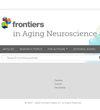阿尔茨海默病:有效诊断和治疗的当前趋势综述
IF 4.5
2区 医学
Q2 GERIATRICS & GERONTOLOGY
引用次数: 0
摘要
痴呆症最常见的病因是阿尔茨海默病。认知能力下降和记忆力加速衰退是其特征。阿尔茨海默病的发展有先后顺序,从临床前期开始,继而出现轻度认知和/或行为障碍,最终导致阿尔茨海默病痴呆症。近年来,人们建议医疗服务提供者在患者出现阿尔茨海默病痴呆症之前,及早诊断阿尔茨海默病。遗憾的是,由于患者和医疗服务提供者倾向于将症状视为典型的衰老迹象而不予重视,因此在临床环境中识别早期阿尔茨海默病可能非常困难。因此,准确、及时地诊断阿尔茨海默病至关重要,这样才能在症状出现之前促进疾病调节疗法和二级预防疗法的发展。诊断过程的目标已经发生了明显的转变,从仅仅确认有症状的阿尔茨海默病的存在转变为在早期无症状阶段识别疾病。要了解疾病修饰疗法的演变,并将有效的诊断和治疗管理付诸实践,就必须理解这一概念。这项研究的成果将增进人们对阿尔茨海默病诊断和治疗现状的深入了解,从而证明有必要寻找潜在的新型生物标志物,以帮助确定疾病的阶段,尤其是早期阶段。有趣的是,研究还详细介绍了最新的药物临床试验情况、非药物治疗方法(如行为矫正、运动和认知训练)以及植物化学物质作为神经保护剂的替代方法。本文章由计算机程序翻译,如有差异,请以英文原文为准。
Alzheimer’s disease: a review on the current trends of the effective diagnosis and therapeutics
The most prevalent cause of dementia is Alzheimer’s disease. Cognitive decline and accelerating memory loss characterize it. Alzheimer’s disease advances sequentially, starting with preclinical stages, followed by mild cognitive and/or behavioral impairment, and ultimately leading to Alzheimer’s disease dementia. In recent years, healthcare providers have been advised to make an earlier diagnosis of Alzheimer’s, prior to individuals developing Alzheimer’s disease dementia. Regrettably, the identification of early-stage Alzheimer’s disease in clinical settings can be arduous due to the tendency of patients and healthcare providers to disregard symptoms as typical signs of aging. Therefore, accurate and prompt diagnosis of Alzheimer’s disease is essential in order to facilitate the development of disease-modifying and secondary preventive therapies prior to the onset of symptoms. There has been a notable shift in the goal of the diagnosis process, transitioning from merely confirming the presence of symptomatic AD to recognizing the illness in its early, asymptomatic phases. Understanding the evolution of disease-modifying therapies and putting effective diagnostic and therapeutic management into practice requires an understanding of this concept. The outcomes of this study will enhance in-depth knowledge of the current status of Alzheimer’s disease’s diagnosis and treatment, justifying the necessity for the quest for potential novel biomarkers that can contribute to determining the stage of the disease, particularly in its earliest stages. Interestingly, latest clinical trial status on pharmacological agents, the nonpharmacological treatments such as behavior modification, exercise, and cognitive training as well as alternative approach on phytochemicals as neuroprotective agents have been covered in detailed.
求助全文
通过发布文献求助,成功后即可免费获取论文全文。
去求助
来源期刊

Frontiers in Aging Neuroscience
GERIATRICS & GERONTOLOGY-NEUROSCIENCES
CiteScore
6.30
自引率
8.30%
发文量
1426
期刊介绍:
Frontiers in Aging Neuroscience is a leading journal in its field, publishing rigorously peer-reviewed research that advances our understanding of the mechanisms of Central Nervous System aging and age-related neural diseases. Specialty Chief Editor Thomas Wisniewski at the New York University School of Medicine is supported by an outstanding Editorial Board of international researchers. This multidisciplinary open-access journal is at the forefront of disseminating and communicating scientific knowledge and impactful discoveries to researchers, academics, clinicians and the public worldwide.
 求助内容:
求助内容: 应助结果提醒方式:
应助结果提醒方式:


